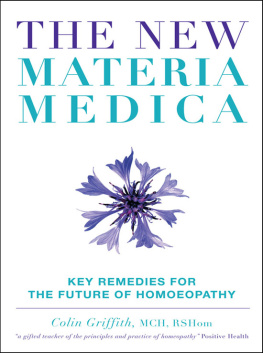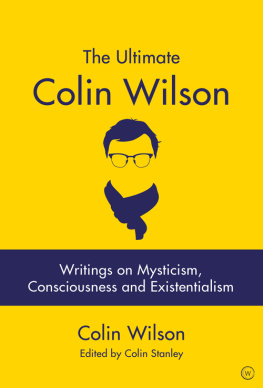Colin Griffith - The Practical Handbook of Homoeopathy: The How, When, Why and Which of Home Prescribing
Here you can read online Colin Griffith - The Practical Handbook of Homoeopathy: The How, When, Why and Which of Home Prescribing full text of the book (entire story) in english for free. Download pdf and epub, get meaning, cover and reviews about this ebook. year: 2008, publisher: Watkins Publishing, genre: Children. Description of the work, (preface) as well as reviews are available. Best literature library LitArk.com created for fans of good reading and offers a wide selection of genres:
Romance novel
Science fiction
Adventure
Detective
Science
History
Home and family
Prose
Art
Politics
Computer
Non-fiction
Religion
Business
Children
Humor
Choose a favorite category and find really read worthwhile books. Enjoy immersion in the world of imagination, feel the emotions of the characters or learn something new for yourself, make an fascinating discovery.
- Book:The Practical Handbook of Homoeopathy: The How, When, Why and Which of Home Prescribing
- Author:
- Publisher:Watkins Publishing
- Genre:
- Year:2008
- Rating:5 / 5
- Favourites:Add to favourites
- Your mark:
- 100
- 1
- 2
- 3
- 4
- 5
The Practical Handbook of Homoeopathy: The How, When, Why and Which of Home Prescribing: summary, description and annotation
We offer to read an annotation, description, summary or preface (depends on what the author of the book "The Practical Handbook of Homoeopathy: The How, When, Why and Which of Home Prescribing" wrote himself). If you haven't found the necessary information about the book — write in the comments, we will try to find it.
Colin Griffith: author's other books
Who wrote The Practical Handbook of Homoeopathy: The How, When, Why and Which of Home Prescribing? Find out the surname, the name of the author of the book and a list of all author's works by series.
The Practical Handbook of Homoeopathy: The How, When, Why and Which of Home Prescribing — read online for free the complete book (whole text) full work
Below is the text of the book, divided by pages. System saving the place of the last page read, allows you to conveniently read the book "The Practical Handbook of Homoeopathy: The How, When, Why and Which of Home Prescribing" online for free, without having to search again every time where you left off. Put a bookmark, and you can go to the page where you finished reading at any time.
Font size:
Interval:
Bookmark:

Colin Griffith MCH, RSHom is a highly respected and effective practitioner of homoeopathy. He studied at the College of Homoeopathy and, instead of writing a thesis, he set up a supervised drop-in clinic which continued for eleven years and became a teaching clinic where students under his supervision set up their own tables. He has always preferred to work in multi-disciplinary practice where other complementary therapies are offered: cranial osteopathy, reflexology, counselling etc. He is a founder member of the Guild of Homoeopaths and lectures regularly at the Centre for Homoeopathic Education, Regents College, London and has lectured in America, Canada, Japan and Greece. He is author of the highly regarded Companion to Homoeopathy.
By the same author
The Companion to Homoeopathy
The New Materia Medica
THE PRACTICAL
HANDBOOK OF
HOMOEOPATHY
The Who, What, Where, Why and How of Homoeopathy
COLIN GRIFFITH

For Sofi with all my love
Acknowledgements
This book would never have been written if it were not for the encouragement and support of my agent, Fiona Spencer-Thomas, and my publisher, Michael Mann. Fiona, a homoeopath herself, has been unstinting with her time and expertise and I cannot thank her enough for believing in my literary efforts. Michael, a champion of practical alternative thinking, has given me invaluable help all through the publishing process. I was too late to acknowledge Annie Wilson for her tact and skill in editing The Companion to Homoeopathy; only she knows how demanding that job was. I should like to make amends by thanking her wholeheartedly for her work on this volume. I am grateful, too, for the help and encouragement Penny Stopa has given me through countless emails and phone calls. I particularly owe special thanks to my fellow homoeopath, Linda Rogerson-Heath, for her careful reading and painstaking correction of the text. Her many years of hospital nursing experience give her an authority I am glad to draw on.
Acknowledgement is due too to all my patients who have found homoeopathy so helpful and in the process taught me so much. Even after all these years in practice I still find it remarkable and encouraging that so many want to follow a way of well-being that is demanding and that requires strength of mind in the face of some pretty tough opposition.
Publishers note
The information in this book is not intended as a substitute for professional medical advice and treatment. If you are pregnant or are suffering from any medical conditions or health problems, it is recommended that you consult a medical professional before following any of the advice or practice suggested in this book. Duncan Baird Publishers, or any other persons who have been involved in working on this publication, cannot accept responsibility for any injuries or damage incurred as a result of following the information or therapeutic techniques contained in this book.
Authors Preface
Homoeopathy is sometimes referred to as an alternative medicine and at other times complementary. It is both but in different areas. Though this book is about the practice of homoeopathy in the home it is also partly about how to think homoeopathically. This means being able to see when homoeopathy is different, even opposite to conventional medicine, as well as knowing when they are able to run a parallel course. Homoeopathy is alternative when it is necessary for the body to discharge and eliminate that which is toxic or waste, be that physical or emotional. It is complementary when surgery or drugs are the only manner in which safety of life is ensured by the removal or suppression of symptoms. Though suppression is the very antithesis of the core philosophy of homoeopathy, it is sometimes vital in an acute crisis or in chronic pathology that has been long established. It is hoped that this book will help readers to see when it is possible to cope with medical problems either by self-prescribing, by consulting a homoeopath or by consulting both a homoeopath and the doctor. In an ideal world all three should be able to confer with understanding of their respective roles.
Foreword
When first asked to produce a first-aid book on homoeopathy, I was daunted by the sheer number of excellent examples already on the shelves. I often recommend patients to get several of them so that if one book might be short on something another would fill the gap. Those by D. M. Gibson, Phyllis Speight, Dorothy Shepherd and Miranda Castro are all highly recommendable and there are many others that serve us well. As the ground rules of homoeopathy are not subject to any appreciable evolutionary change, it would seem superfluous to add yet another title to the list. It has taken me a while to see what might be useful to people who have an interest in using homoeopathy in the home that has not been covered already.
Two things have helped me to get past this little block. Firstly, having taken eight years to write The Companion To Homoeopathy, a hefty tome on the philosophy on which homoeopathy depends and how it works in practice, a complementary book on the practical application of homoeopathy in the home was suggested. Secondly, I remembered the pleas of many of my patients (chiefly mothers) over the years as to when I would write a book to answer the queries they kept ringing me about. People want to know about home practice; they want to participate in their own healing; they want to understand what and why and when to take responsibility.
Homoeopathy in the home what exactly could this cover? There are so many people who have come to use and trust homoeopathic medicines for first aid that the demand for more information has spawned an industry that would surprise many by its size and profitability! Nowadays you can walk into any health food store and buy homoeopathic remedies to treat all manner of complaints from colds and hay fever to gastric flu and muscle strain. You can go to any of the homoeopathic pharmacies and ask for any one of literally hundreds of different remedies that might be used for the treatment of any conceivable complaint. A glance at the chapter headings will show you just how wide-ranging homoeopathy can be and how far homoeopathic treatment should be considered as an option, not just in home practice but in the wider context of a first choice for chronic complaints. (Chronic complaints should always be referred to a professional, qualified practitioner.) Home practice should include more than the use of first-aid remedies for minor acute ailments; it should also be the recognition of when to call the homoeopath, of when another complementary therapy would speed progress, of when expert conventional treatment is needed for problems outside the range of other therapies and when to leave well alone.
For relatively straightforward acute problems such as coughs, colds, bruises and strains many people just plunge in and try out the remedies on a hope for the best basis. Theres nothing wrong with that its a good place to start. It is virtually impossible to do any harm with homoeopathic medicines; even if you do choose an inappropriate remedy no one will suffer more for it, unless delay causes a serious condition to be left untreated. However, the suck it and see school of first aid is not really satisfactory after a while. Once a home prescriber has tasted the sweet satisfaction of success in dealing with a cold or a headache or a menstrual cramp, she will want to do more. Homoeopathy is moreish. Once youve got the bug, it doesnt let go. This is when first-aid books come in handy. Much thumbed booklets are ready on the kitchen shelf to indicate what remedies to use for a deep cut or a bad fall, an irritating cough or an incipient cold. Bolder prescribers want to be able to tackle a high fever or a bout of food poisoning. But what do you do if little Marks fever has not lifted despite giving
Font size:
Interval:
Bookmark:
Similar books «The Practical Handbook of Homoeopathy: The How, When, Why and Which of Home Prescribing»
Look at similar books to The Practical Handbook of Homoeopathy: The How, When, Why and Which of Home Prescribing. We have selected literature similar in name and meaning in the hope of providing readers with more options to find new, interesting, not yet read works.
Discussion, reviews of the book The Practical Handbook of Homoeopathy: The How, When, Why and Which of Home Prescribing and just readers' own opinions. Leave your comments, write what you think about the work, its meaning or the main characters. Specify what exactly you liked and what you didn't like, and why you think so.













